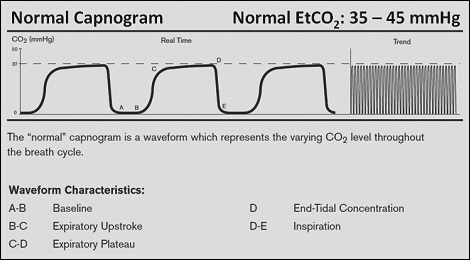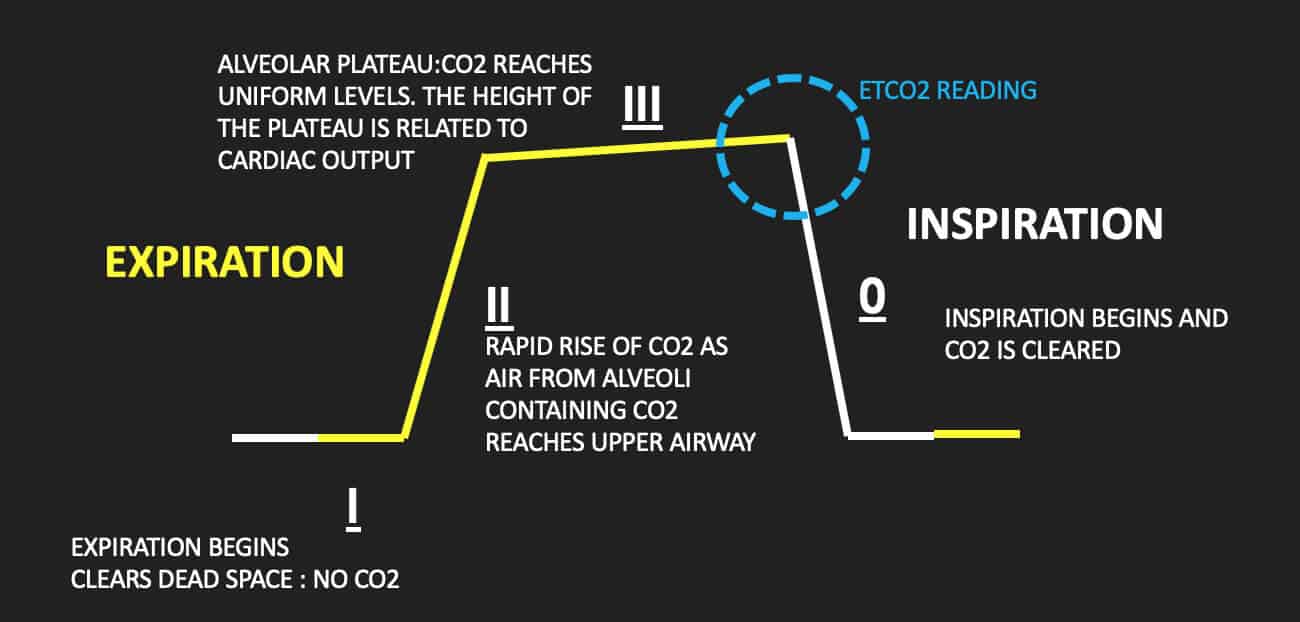end tidal co2 range high
423 20 mmHg versus 34 255 mmHg. Although the normal range for CO2 should be between 35-45mmHg CO2 monitoring gives healthcare providers a lot more insight into what is going on with a patients condition.

Waveform Capnography In The Intubated Patient Emcrit Project
Graphically this difference in ROSC vs non-ROSC PetCO2 for both groups appeared to be even greater at ten minutes.
. The median ETCO 2 value was 32 mmHg IQR 27 38 mmHg range 18-80 mmHg. NaHC03 will increase EtCO2 because it splits into CO2 and H20 So if rises after NaHCO3 do not misinterpret as ROSC Vasopressors will decrease ETCO2 they cause high afterload increasing BP and myocardial blood flow but a decrease in cardiac output. 24 The VdVt of adult patients with acute lung injury is generally 040-055 and for those patients with acute respiratory distress syndrome ARDS a significantly elevated VdVt is.
End-tidal CO2 EtCO2 monitoring is a measure of metabolism perfusion and ventilation. The waveform is called capnograph and shows how much CO 2 is present at each phase of the respiratory cycle. The median EtCO2 at T0 and T60 was 35 IQR.
30-38 and 34 IQR. End-Tidal CO2 in Cardiopulmonary Resuscitation EtCO2 in CPR. Since problems with lungs are not common and gas exchange between alveoli and the blood is swift and effective.
1-3 Clinicians may however observe a widened or increased gradient caused by physiologic dead. ETCO2 emergency department monitoring and critical. The purpose of the present study was to determine the value of end-tidal CO2 EtCO2 in screening for sleep apneas.
These cases demonstrate the efficacy of monitoring end-expired CO2 concentrations in patients at risk from malignant hyperthermia as well. The normal physiologic dead space to tidal volume ratio VdVt is 020-035. 428 153 mmHg versus 323 141 mmHg.
In the ED we typically think of a EtCO2 as a marker of perfusion and ventilation. In mmHg the PetCO2 values for those with and without ROSC after five minutes of CPR was. However EtCO2 is an extremely powerful surrogate for endotracheal tube ETT P osition CPR Q uality R eturn of.
In conditions of normal breathing 6 Lmin 12 breathsmin 500 ml for tidal volume etCO 2 is very close to alveolar CO2. End Tidal CO 2 6 Can also be measured and monitored in spontaneously. Forty-six of 96 48 95 confidence interval CI 38 58 patients had abnormal ETCO 2 values including 37 39 95 CI 29 49 with low ETCO 2 levels and.
Capnography waveforms etCO2 and breathing patterns. In this study the aim was to review the applications of end-tidal carbon dioxide ETCO2 monitoring in emergency department multiple databases were comprehensively searched with combination of following keywords. According to the book by Hockenberry and Wilson 2015 p 1140 normal values of ETCO2 are 30-43 mmHg which is slightly lower than arterial PaCO2 35-45mmHg.
The diagnosis of sleep apnea syndrome SAS requires expensive and complex instrumentation. The number is called capnometry which is the partial pressure of CO 2 detected at the end of exhalation ranging between 35 - 45 mm Hg or 40 57 kPa. In normal healthy lungs the match of arterial carbon dioxide and exhaled CO 2 is closely correlated.
There was no significant change in EtCO2 after treatment. Thirty-nine patients referred to our sleep laboratory because of suspected SAS and ten normal subjects were studied. With a normal match of alveolar ventilation and perfusion this gradient is roughly 2 to 5 mmHg where the arterial carbon dioxide is greater than the exhaled carbon dioxide.
A low end-tidal CO2 may indicate poor perfusion hypovolemia or sepsis. This led to nearly immediate detection and adequate treatment with sodium dantrolene. There was no significant change in the Q angle and the T time after treatment.
The height of the capnography waveform accompanies this number on the monitor as well as the. End tidal CO 2 EtCO 2 monitoring is the fastest indicator of ventilatory compromise. During positive pressure ventilation a concentration of 45 should be maintained so that arterial carbon dioxide tensions are maintained within the normal physiological range.
Capnography can be used to measure end-tidal CO 2. The median initial PEFR was 200 interquartile range IQR. The amount of CO2 at the end of exhalation or end-tidal CO2 ETCO2 is normally 35-45 mm HG.
Two cases of malignant hyperthermia are described where the earliest sign was a rise in the end-tidal CO2 concentration. Animals that are breathing spontaneously should have an end-tidal carbon dioxide concentration in the range of 46. Capnograph is an indispensable tool for monitoring metabolic and respiratory function.
Riding The Wave Of Capnography Understanding Etco2 Vetbloom Blog

3 Waveform Capnography Showing Changes In The End Tidal Carbon Dioxide Download Scientific Diagram

The Impact Of Ventilation Rate On End Tidal Carbon Dioxide Level During Manual Cardiopulmonary Resuscitation Resuscitation
Emdocs Net Emergency Medicine Educationcapnography In The Ed Emdocs Net Emergency Medicine Education

End Tidal C02 Worth The Investment

Waveform Capnography In The Intubated Patient Emcrit Project
End Tidal Co2 Monitoring In The Pre Hospital Environment More Than Just Endotracheal Tube Placement Confirmation Journal Of Paramedic Practice

Capnography Provides Bigger Physiological Picture To Maximize Patient Care Jems Ems Emergency Medical Services Training Paramedic Emt News

Quantitative Waveform Capnography Acls Medical Training

Etco2 Valuable Vital Sign To Assess Perfusion The Airway Jedi

Capnogram R Series Defibrillator Zoll Medical Uk

Exhaled Carbon Monoxide End Tidal Co2 And Peripheral Oxygen Saturation Download Table

Potential Applications Of Capnography In The Prehospital Setting Journal Of Paramedic Practice

End Tidal Capnography Can Be Useful For Detecting Diabetic Ketoacidosis Monitoring Copd Acep Now

Exhaled Carbon Monoxide End Tidal Co2 And Peripheral Oxygen Saturation Download Table

Waveform Capnography In The Intubated Patient Emcrit Project

Average Etco2 Kpa During Cpr In Patients With Or Without Rosc Download Scientific Diagram
